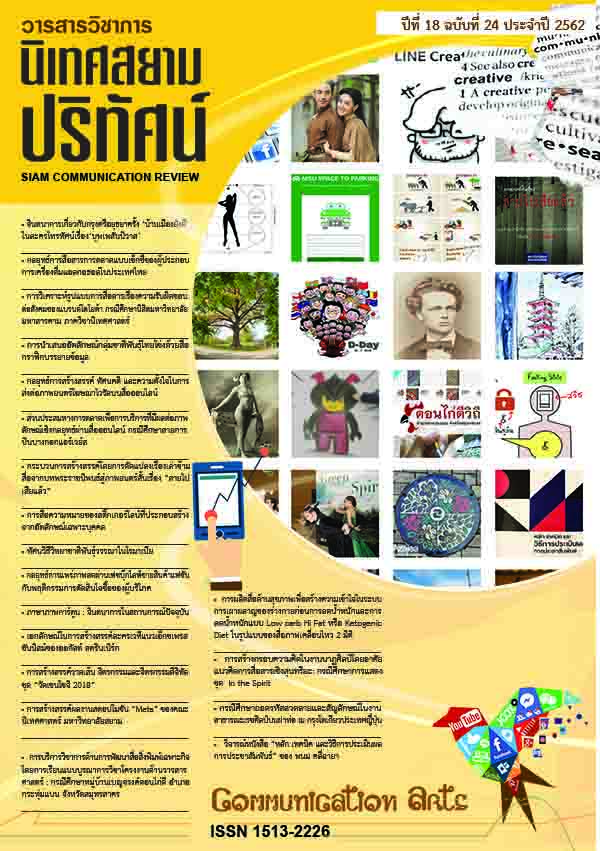Facebook Live Strategies and Consumers’ Decisions in Buying Fashion Product
Main Article Content
Abstract
The objectives of this research were to study 1) strategies used to sell fashion products with live streaming via Facebook Live; 2) Facebook Live fashion products watching behavior of consumers; 3) consumers’ satisfaction with the factors of communication with fashion sellers via Facebook Live; 4) consumers’ buying decisions and their attitudes regarding buying decisions; 5) the relationships between demographic factors and buying decisions; 6) the relationship between consumers’ Facebook Live fashion products watching behavior and their decisions to buy; 7) the relationship between the factors of communication with fashion sellers via Facebook Live and consumers’ buying decisions and their attitudes regarding buying decisions; and 8) the role of family and friends in consumers’ decisions to buy fashion products seen on Facebook Live. This research used mixed methods. For the qualitative part, the key informants were 4 fashion product sellers who had 9,000 or more followers on Facebook Live. The data collection tool was an interview form. Data were analyzed using descriptive analysis. For the quantitative part, a questionnaire was administered to a sample of 418 consumers who watched live streaming of fashion products via Facebook Live. The samples were chosen using multi stage sampling. Data were analyzed using frequency, percentage, mean, standard deviation, chi square and Pearson’s correlated coefficient The results showed that 1) the fashion sellers used 4 strategies: (a) making the video streams fun so people would want to watch, (b) building credibility of the presenter and the channel, (c) using persuasive communication involving the 4Ps of marketing, and (d) providing good after-sales services. 2) Most sample consumers watched the live streams at home on their smart phones 1 or 2 times a week. They normally watched during the time period 20:01 – 23:00 when they had free time. They participated by clicking “like,” following and sharing. They were mainly interested in apparel, followed by handbags. 3) Consumers were highly satisfied with the marketing mix information that they received, with the presenters in the video streams and with the communications technology through Facebook Live. 4) After watching, 32.3 % of consumers decided to buy the products, 61% were undecided and only 6.7% decided not to buy the products. They had a highly positive attitude about their buying decisions. 5) Consumers of different sex and different age groups made different buying decisions. 6) Facebook Live fashion products watching behavior was related to consumers’ decisions to buy. 7) Three factors of communication related to Facebook Live broadcasting, consisting of (a) satisfaction with 4Ps marketing mix information, (b) satisfaction with the presenters, and (c) satisfaction with the Facebook Live technology, were all related to consumers’ decisions to buy and their attitudes toward their decisions to buy. 8) The role of family and friends was not related to consumers’ decisions to buy fashion products seen on Facebook Live.
Article Details
References
จันทร์ ชุ่มเมืองปัก. (2546). แรงจูงใจและการจูงใจสร้างปาฏิหาริย์. กรุงเทพ: ดอกหญ้า.
จิดาภา ทัดหอม. (2558). การตลาดผ่านสื่อสังคมออนไลน์ ความไว้วางใจและคุณภาพของระบบสารสนเทศที่มีผลต่อการตัดสินใจซื้อสินค้าผ่านช่องทางการถ่ายทอดสดเฟซบุ๊กไลฟ์ (Facebook Live) ของผู้บริโภคออนไลน์ในกรุงเทพมหานคร. การค้นคว้าอิสระปริญญามหาบัณฑิต, มหาวิทยาลัยกรุงเทพ.
ชาญเดช วีรกุล. (2552). "ตวามสัมพันธ์ระหว่างแรงจูงใจในการปฏิบัติงานกับขวัญในการปฏิบัติงานของบุคคลากรสังกัดสำนักงานตรวจเงินแผ่นดินภูมิภาค 5 (จังหวัดอุบลราชธานี)" วิทยานิพนธ์ปริญญามหาบัณฑิต สาขาการจัดการทั่วไป, มหาวิทยาลัยราชภัฏอุบลราชธานี.
บุษบา สุธีธร. (2560). การวางแผนสื่อสารเชิงกลยุทธ์. กรุงเทพฯ: เดอะนิวกรุ๊ป.
พิบูล ทีปะปาล. (2547). กลยุทธ์การตลาด. กรุงเทพมหานคร: อมรการพิมพ์.
พีระ จิรโสภณ. (2557). ทฤษฎีการใช้ประโยชน์และการตอบสนองความพึงพอใจ. นนทบุรี: มหาวิทยาลัยสุโขทัยธรรมาธิราช.
วิวิศน์ ใจดาบ. (2556). ปัจจัยที่มีผลต่อการตัดสินใจซื้อเบเกอรี่ของผู้บริโภคในกรุงเทพมหานคร. การค้นคว้าอิสระปริญญามหาบัณฑิต, มหาวิทยาลัยกรุงเทพ.
สมสุข หินวิมาน. (2548). ทฤษฎีการสื่อสารกับโลกาภิวัตน์. ใน มหาวิทยาลัยสุโขทัยธรรมาธิราช. บัณฑิตศึกษา. สาขาวิชานิเทศศาสตร์, ประมวลสาระแนวการศึกษาชุดวิชาปรัชญานิเทศศาสตร์และทฤษฎีการสื่อสาร หน่วยที่ 11 (เล่ม 2, น. 226-292). นนทบุรี: มหาวิทยาลัยสุโขทัยธรรมาธิราช.
เสรี วงษ์มณฑา. (2547). ครบเครื่องเรื่องการสื่อสารการตลาด. กรุงเทพมหานคร: ธรรมสาร.
ภาษาอังกฤษ
Cutlip S. M. & Center. (1978). Effective public relation. New Jersey: Englewood Cliffs.
Edward K. Strong Jr. (1925). Psychology of Selling and Advertising. New York: McGrew-Hill.
Philip Kotler. (1997). Marketing Management Analysis, Planning, Implementation and Control (9th ed.). New Jersey: A Simon & Schuster.
Schiffman Leon G. & Leslie Lazar Kanuk. (1994). Consumer Behavior (5th ed.). NJ: Prentice Hall: Englewood Cliffs.
ออนไลน์
ทีมข่าวไทยรัฐออนไลน์. (2557, 26 สิงหาคม). ผลวิจัยชี้เฟซบุ๊ก เป็นสังคมออนไลน์ครองใจคนไทยในปี 57. ไทยรัฐออนไลน์. เข้าถึงได้จาก https://www.thairath.co.th/content/445964
สพธอ. (2560). ETDA เผยผลสำรวจพฤติกรรมใช้อินเทอร์เน็ตและมูลค่าอีคอมเมิร์ซ โชว์ความพร้อมไทยก้าวขึ้นเป็นเจ้าอีคอมเมิร์ซอาเซียน. เข้าถึงได้จาก https://etda.or.th/content/thailand-internet-user-profile-2017-and-value-of-e-commerce-survey-in-thailand-2017l-press-conference.html
. (2560). รายงานผลการสำรวจมูลค่าพาณิชย์อิเล็กทรอนิกส์ในปี 2560. เข้าถึงได้จาก http://www.etda.or.th/publishing-detail/value-of-ecommerce-survey-2017.html


